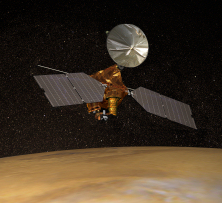New evidence for a warmer and wetter early Mars
6 December 2016
A recent study from ESA's Mars Express and NASA's Mars Reconnaissance Orbiter (MRO) provides new evidence for a warm young Mars that hosted water across a geologically long timescale, rather than in short episodic bursts – something that has important consequences for habitability and the possibility of past life on the planet. |
| Hellas Basin on Mars. Credit: MOLA Science Team |
Although water is known to have once flowed on Mars, the nature and timeline of how and when it did so is a major open question within planetary science.
The findings follow an analysis of a region of relatively smooth terrain, called inter-crater plains, just north of the Hellas Basin. With a diameter of 2300 km, the Hellas Basin is one of the largest identified impact craters both on Mars and within the Solar System, and is thought to have formed some 4 billion years ago.
"These plains on the northern rim of Hellas are usually interpreted as being volcanic, as we see with similar surfaces on the Moon," said Francesco Salese of IRSPS, Università "Gabriele D'Annunzio", Italy, and lead author on the new paper. "However, our work indicates otherwise. Instead, we found thick, widespread swathes of sedimentary rock."
Sedimentary and volcanic (igneous) rocks form in different ways – volcanic, as the name suggests, needs active volcanism driven by a planet's internal activity, while sedimentary rock usually requires water. Igneous rock is created as volcanic deposits of molten rock cool and solidify, while sedimentary builds up as new deposits of sediment form layers that compact and harden over geologically long timescales.
"To create the kind of sedimentary plains we found at Hellas, we believe that a generally aqueous environment was present in the region some 3.8 billion years ago," said Salese. "Importantly, it must have lasted for a long period of time – on the order of hundreds of millions of years."
A volatile adolescence?
There are a couple of key models for early Mars – both involve the presence of liquid water, but in vastly different ways.
Some studies suggest that Mars' earliest days (the Noachian period, over 3.7 billion years ago) had a steadily warm climate, which enabled vast pools and streams of water to exist across the planet's surface. This watery world then lost both its magnetic field and atmosphere and cooled down, transforming into the dry, arid world we see today.
Alternatively, rather than hosting a warm climate and water-laden surface for eons, Mars may instead have only experienced short, periodic bursts of warmth and wetness that lasted for less than 10 000 years each, facilitated by a sputtering cycle of volcanism that intermittently surged and subsided across the years.
Both scenarios could form some of the water-dependent chemistries and rock morphologies we see across Mars' surface, and have significant consequences for Mars in both a geological sense – how the planet formed and evolved, whether its past has anything in common with Earth's, and the composition and structure of its surface – and in terms of potential habitability."Understanding if Mars had a warmer and wetter climate for a long period of time is a key question in our search for past life on the Red Planet," said co-author Nicolas Mangold of CNRS-INSU, Nantes University, France.
"If we can understand how the martian climate evolved, we'll have a better understanding of whether life could have ever flourished, and where to look for it if it did. We can also learn much about rocky planets in general, which is especially exciting in this era of exoplanet science, and about our own planet – the same processes we think to have been important on a young Mars, such as sedimentary processes, volcanism, and impacts, have also been crucial on Earth."
From formation to erosion
Salese and colleagues used imaging and spectro-imaging data from Mars Express and MRO to create a detailed geological map of the area around northern Hellas, taking advantage of so-called "erosional windows" – geological formations that act as natural "drill holes" down into the plains, revealing deeper material (examples include impact craters, grabens, and outcrops).
 |
| Geological map of region north of Hellas Basin. Credit: from Salese et al., 2016. J. Geophys. Res. Planets, 121, doi:10.1002/2016JE005039, Reused with permission of the American Geophysical Union. |
These data showed the plains to be composed of an over 500-metre-thick band of flat, layered, light-coloured rock. The rock showed several characteristics typical of sedimentary deposition: box-work, which is a type of box-like mineral structure formed by erosion; cross-bedding, identified as layers of rock intersecting at different tilts and inclines; and planar stratification, which manifests as distinct, near-horizontal layers of rock that line up atop one another. These were in addition to large amounts of clays known as smectites.
Clays are exciting chemicals, as they indicate that a wet and thus potentially habitable environment once existed at that location. Clays can also trap organic material and potentially preserve signs of life.
"These characteristics suggest that the rock didn't form from lava flow deposits but rather from sedimentary processes, which implies that the region once experienced warm and wet conditions for a relatively long time," said Salese. "When the layered rock was deposited – during the Noachian period, around 3.8 billion years ago – its surroundings must have been soaked in water, with intense liquid circulation. We think it likely formed in a lake (lacustrine) or stream (alluvial) environment, or a combination of both."
The rock then underwent an intense period of volcanic erosion during the Hesperian period (3.7 to 3.3 billion years ago) and was covered by volcanic flows, creating the morphology we see today. The scientists estimate a minimum erosion rate for this time period of one metre per million years – one hundred times higher than the erosion rates estimated on Mars in the past 3 billion years.
"This is further evidence of a prolonged period of active geological processes on the surface of early Mars," added Mangold. "We can also extrapolate our finding to the rest of Mars and be confident we understand the evolution of the planet as a whole – we believe that the global climate conditions of Noachian Mars were sufficient to support significant liquid water."
Cosmic Collaboration
This study used data from Mars Express and MRO, which allowed the scientists to explore the region's appearance, topography, morphology, mineralogy, and age. More specifically, Mars Express imaging data allowed Salese and colleagues to study the plains' geology on a regional scale, providing context for the local-scale observations from MRO.
The presence of rock morphologies or minerals that imply a wet history point towards possible habitability at that location in the past – something that is important in selecting landing sites and areas of interest for future robotic and potential human missions to Mars.
"This work again demonstrates the importance of successful cooperation between different missions, and collaboration between ESA and NASA," said Dmitri Titov, ESA Project Scientist for Mars Express. "No mission would be able to unveil the history of Mars alone. By using multiple spacecraft and different observation techniques, it's possible to characterise all kinds of different geological processes on Mars in all their complexity, and gain a more complete view of Mars' early days."
This finding is part of a series of efforts to understand Mars' history and the planet as a whole, performed using Mars Express and other spacecraft – from studying Mars' early climate by probing the evolution of large lakes that once existed across the planet's surface, to observing Mars' present-day weather (including mystery clouds and aurorae), and characterising the pockets of magnetism locked up within its crust.
More information
The study comprised imaging, topographic, and mineralogical data from the High Resolution Stereo Camera (HRSC) and Visible and Infrared Mineralogical Mapping Spectrometer (OMEGA) aboard ESA's Mars Express, and the High Resolution Imaging Science Experiment (HiRISE), Context Camera (CTX), and Compact Reconnaissance Imaging Spectrometer for Mars (CRISM) instruments aboard NASA's Mars Reconnaissance Orbiter.
Related publication
F. Salese, V. Ansan, N. Mangold, J. Carter, A. Ody, F. Poulet, and G. G. Ori (14 November 2016), "A sedimentary origin for intercrater plains north of the Hellas basin: implications for climate conditions and erosion rates on early Mars", J. Geophys. Res., doi:10.1002/2016JE005039.
For further information, please contact:
Francesco Salese
IRSPS, Università "Gabriele D'Annunzio", Pescara, Italy;
and LPG Nantes, University of Nantes, France
Email: francesco.salese![]() unich.it
unich.it
Webpage: www.francescosalese.com
Twitter: @salesefra
Nicolas Mangold
CNRS-INSU/Nantes University,
Nantes, France
Email: nicolas.Mangold![]() univ-nantes.fr
univ-nantes.fr
Dmitri Titov
ESA Mars Express Project Scientist
Directorate of Science
European Space Agency
Email: dmitri.titov![]() esa.int
esa.int









